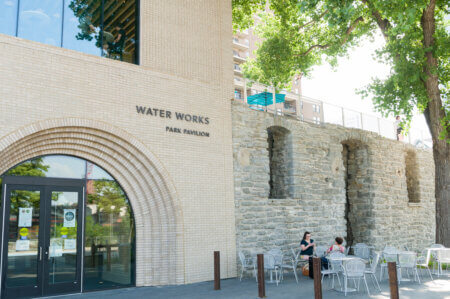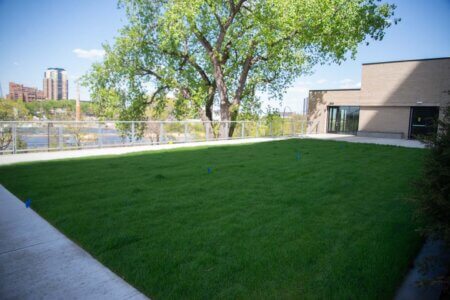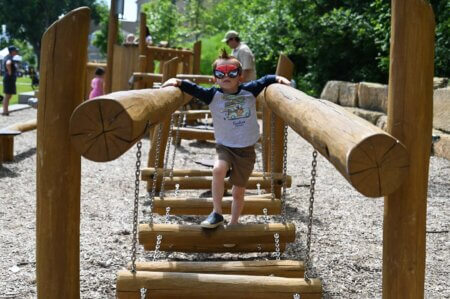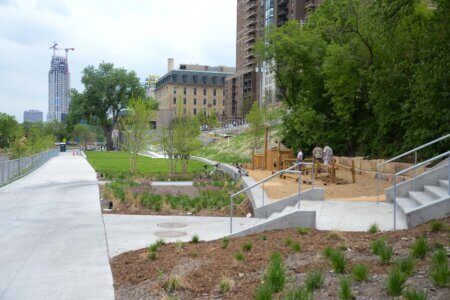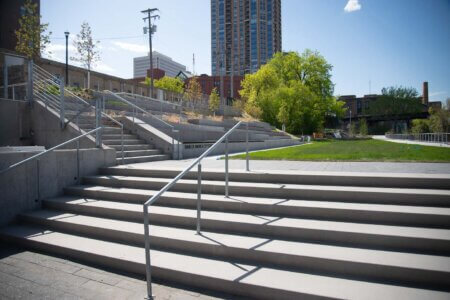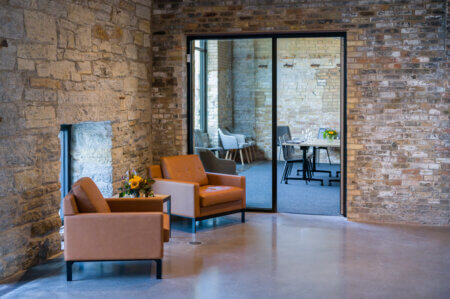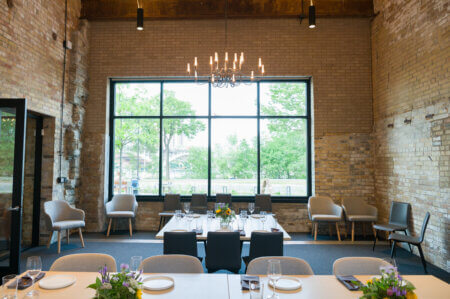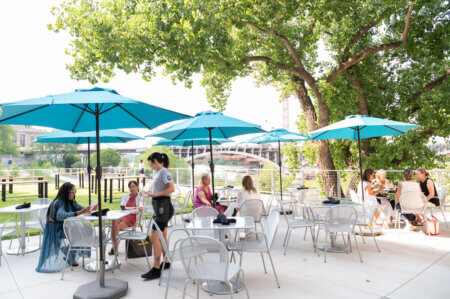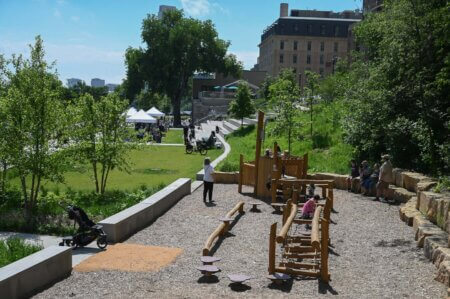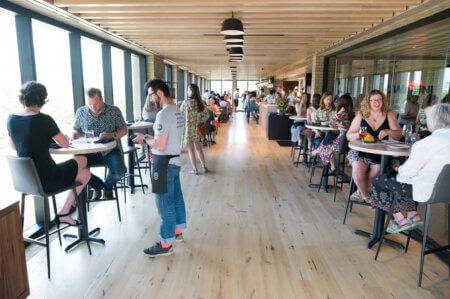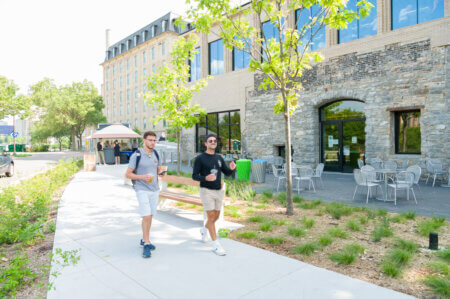Take a self-guided tour of Water Works, courtesy of the Minneapolis Parks Foundation!
Address
425 West River Parkway
Minneapolis, MN 55401
Contact
General: 612-230-6400
Email: waterworks@minneapolisparks.org
Hours
Park: 6 AM to midnight
Ordinance PB-2-33
Water Works Pavilion building: 10 AM to 8 PM
Owamni : Tuesday – Sunday, 11 Am – 9 PM
Recreation Center
Water Works Pavilion Information and Hours
View Photo GallerySelf Guided Tours
Programs
The Minneapolis Park and Recreation Board is excited to share new programs and bring back some of your favorites for 2023. Please check back for new programming opportunities! If you have ideas for Water Works, a class you would like to teach or a program you would like to see please contact us at waterworks@minneapolisparks.org.
Free Daily Drop-In Activities
All activities are free and do not require registration
Outdoor Exploration Kits
Every day, 10:30 am-9 pm,
Enjoy the riverfront with tree or bird identification kits, binoculars, or native flower coloring books and crayons. Check out a bag and go explore!
Games
Every day, 10:30 am-9 pm
Play Bags, Bocce, Frisbee or Lawn Dice. Borrow one of the classics or try something new! Table games also available for checkout to play at any of the nearby park tables, or bring a blanket and play in the grass.
View Game Inventory
Self-Guided Art Tour
Did you know there are 20 major public artworks in Downtown Minneapolis? Check out our interactive, online art tour! Use the link below to take a self-guided tour with directions and information about each artwork.
Downtown Minneapolis Public Art Tour
Features & Amenities
Outdoor
- General Mills Plaza with three gas firepits
- Bank of America City Steps with social seating and terraced green spaces
- Columbia Terrace with outdoor dining space and event lawn overlooking St. Anthony Falls
- Nature Play Lab, nature-themed playground for small children
- Mezzanine lawn with open green space overlooking St. Anthony Falls
- Stone remnant walls from Occidental and Columbia mills
- Industrial relics unearthed during construction
- Street/trail connection called a woonerf connects to Second Street
- Native plants, many with medicinal and edible properties, featured in Owámniyuomni ed Wathóthoka kiŋ/Plants of Owamniyuomni: A Dakota Language Audio Tour
- Dine-in Indigenous cuisine from Owámni by The Sioux Chef
- Carefully preserved mill remnants from Bassett’s Sawmill and Columbia Flour Mill
- Visitor Center Welcome Desk
- Lenzmeier Family Foundation Classroom
- Six bathrooms, three fully accessible
- Water fountain and water bottle filler
- Adult-sized changing table
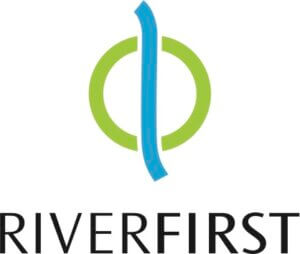
This project is part of RiverFirst, a generational vision for transforming once-industrial Mississippi Riverfront into a welcoming place for all people through improved habitat and miles of new interconnected parks and trails.
Park Details
Good to Know
Water Works was created in partnership with the Minneapolis Parks Foundation.
Rentals & Permits
Reserve Water Works
Host an event at Water Works! With flexible layouts for groups from 4 to 40 Water Works has options to suit your next special occasion, meeting or gathering. Contact us for more information.
Outdoor Use and Event Space: Learn how to reserve park space for corporate events, community celebrations, and more.
Outdoor Weddings: Make your outdoor ceremony unique and memorable. View wedding permit details.
Annual Patron Parking Permit: Enjoy parking privileges in specially designated spaces at some of our most popular regional parks. View parking permit details.
History
People have gathered at Owámniiyomni (St. Anthony Falls) for thousands of years. It was a prime place for encampments by the Dakhóta, Ho-Chunk, and Ojibwe due to the proximity to a place of spiritual power, traditional routes, and locations for harvesting foods such as maple sugar and cranberries. Even after the European settlement of the cities of St. Anthony and Minneapolis, Native peoples continued to stay at the Falls through the 1860s, when they were forcibly relocated to reservations.
Minneapolis grew around industrial development on the Mississippi River. Loggers gathered for work at the city’s saw mills, then some of the world’s largest flour mills were built, harnessing the power of the river as the city continued to grow. Water Works showcases carefully excavated mill remnants from the Bassett Sawmill, which was built in 1870 and burned in 1897, and Columbia Flour Mill, which was built in 1882 and collapsed in 1941.
The decline of riverfront industry in the mid-20th century was followed by a central riverfront revitalization, led by the Fuji Ya restaurant. When it opened in 1968, Fuji Ya was the first new building in an abandoned industrial area of Minneapolis, spurring the beginning of a riverfront redevelopment period that continues to this day. Beams salvaged from the Fuji Ya building were used to build the staircase in the Water Works Pavilion.
Acquisition and Development: MPRB bought the site in 1990 after Fuji Ya moved. It was during an era of riverfront park development that saw the Stone Arch Bridge transition from railroad to pedestrian and bike use, an expansion of trails on West River Parkway and the development of Boom Island Park.
The site lay dormant for more than 20 years. Following an international riverfront park design competition in 2010, the MPRB launched RiverFirst, a generational vision for transforming areas of once-industrial Mississippi Riverfront into a welcoming place for all people through improved habitat and miles of new interconnected parks and trails. Water Works was one of the first projects identified through RiverFirst.
Other RiverFirst projects include Hall’s Island, a habitat-rich island and gravel beach restored in 2018 after it was destroyed by 1960s industrial expansion, and the 26th Avenue North Overlook, a new North Minneapolis river overlook and trail connection that also opened in 2021.
Construction on Water Works started with archeological investigation that began in 2017. Park and pavilion construction began in 2019, and the project was completed in the summer of 2021.








